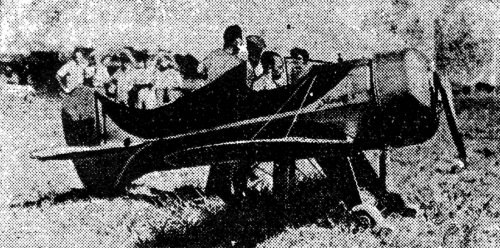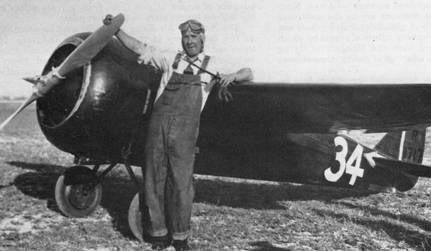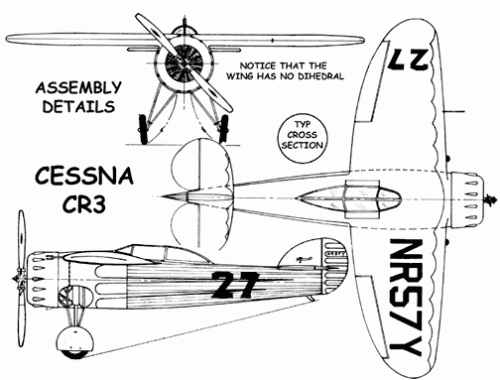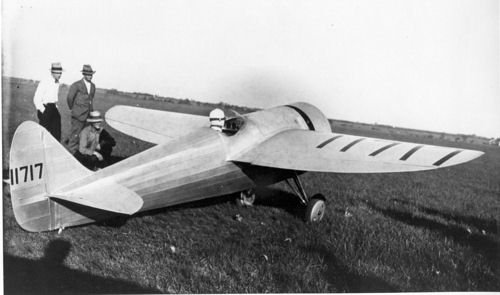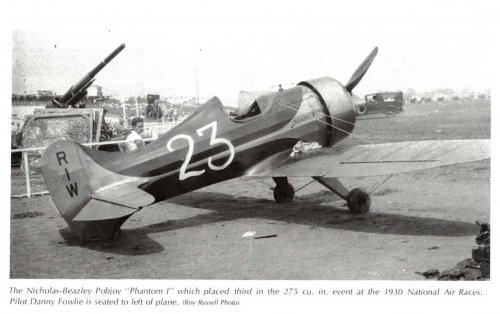- Joined
- 25 June 2009
- Messages
- 14,758
- Reaction score
- 6,164
Here is a forgotten little airplane with quite an interesting career.
The Phantom I [R1W] miniature racing plane (also refered to as the "Pobjoy Raceplane") is commonly listed as a product of Nicholas-Beazley, a company based in Marshall, Missouri. The truth, however, is a little more complicated than that. The Nicholas-Beazley Airplane Company had imported a British Pobjoy engine with a gear reduction unit for use in its new design, the NB-3.
Designer Robert T. Jones (who would later became famous as the co-inventor of swept wings for transonic flight) computed the weight and balance for the setup and proposed a new design as an air-racer. Claude Flagg and H. G. Landis1 built the aircraft in their spare time under the Marshall Aircraft Laboratories monicker and patented the wing design. The Nicholas-Beazley company, however, conducted the tests and produced the subsequent engineering report on the machine, under the supervision of inhouse chief engineer T. A. Kirkup, who also designed most N.-B. aircraft2.
The total weight of the monoplane was 355 pounds. It featured a patented wing of unusual construction3, with a spread of 21' 9"; its fuselage was 12' 9" in length. Of all metal construction, the Phantom I was powered with a 65 hp Pobjoy P (Niagara II) motor and was slated as capable of making more than 200 miles an hour. The Phantom I was given an "R" license by the federal government and, piloted by Danny A. Fowlie of Morris, Illinois, was entered in the 1930 National Air Races in Chicago from August 23 to September 1. Picture below shows pilot Fowlie at Commercial Airport, Springfield, Illinois.

In 1932, after famed racing ace Steve Wittman purchased the aircraft (the only one of his racers he didn't build), the cockpit became enclosed and the Pobjoy P engine was replaced with a Pobjoy R of 75 hp. The aircraft (now called the Pobjoy Special) set many records in 1933-34. Picture below shows N6119G / R1W/7 (cn T-9) a replica of the Pobjoy Special on display at the EAA Pioneer Airport.

But that was not the end of the diminutive racer as it eventually resurfaced in 1948 as the Reaver Special midget racer, with a 22' wing and the more powerful 85 hp Continental engine!
1 Wrongly called "H. F. Landis" by Wikipedia.
2 Contrary to what Aerofiles states, the Phantom I was NOT designed by Kirkup (see the second link below for the whole story).
3 Robert T. Jones's report on the aircraft's wing analysis, dated January 1930, is no longer available online. I'm attaching it below for reference.
More on the Phantom I/Pobjoy Special:
http://en.wikipedia.org/wiki/Nicholas-Beazley_Pobjoy_Special
http://www.oshkosh365.org/saarchive/eaa_articles/1998_11_14.pdf
The Phantom I [R1W] miniature racing plane (also refered to as the "Pobjoy Raceplane") is commonly listed as a product of Nicholas-Beazley, a company based in Marshall, Missouri. The truth, however, is a little more complicated than that. The Nicholas-Beazley Airplane Company had imported a British Pobjoy engine with a gear reduction unit for use in its new design, the NB-3.
Designer Robert T. Jones (who would later became famous as the co-inventor of swept wings for transonic flight) computed the weight and balance for the setup and proposed a new design as an air-racer. Claude Flagg and H. G. Landis1 built the aircraft in their spare time under the Marshall Aircraft Laboratories monicker and patented the wing design. The Nicholas-Beazley company, however, conducted the tests and produced the subsequent engineering report on the machine, under the supervision of inhouse chief engineer T. A. Kirkup, who also designed most N.-B. aircraft2.
The total weight of the monoplane was 355 pounds. It featured a patented wing of unusual construction3, with a spread of 21' 9"; its fuselage was 12' 9" in length. Of all metal construction, the Phantom I was powered with a 65 hp Pobjoy P (Niagara II) motor and was slated as capable of making more than 200 miles an hour. The Phantom I was given an "R" license by the federal government and, piloted by Danny A. Fowlie of Morris, Illinois, was entered in the 1930 National Air Races in Chicago from August 23 to September 1. Picture below shows pilot Fowlie at Commercial Airport, Springfield, Illinois.
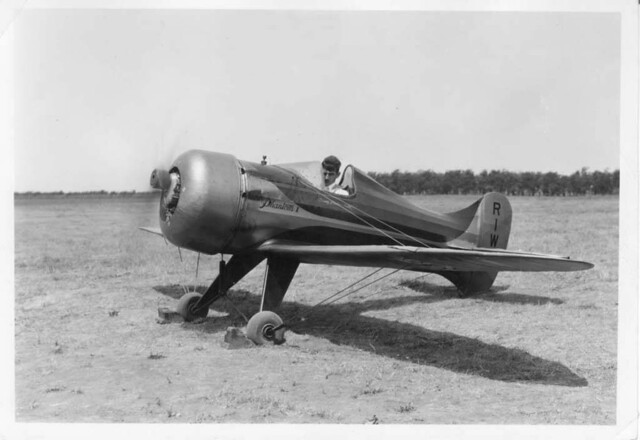
In 1932, after famed racing ace Steve Wittman purchased the aircraft (the only one of his racers he didn't build), the cockpit became enclosed and the Pobjoy P engine was replaced with a Pobjoy R of 75 hp. The aircraft (now called the Pobjoy Special) set many records in 1933-34. Picture below shows N6119G / R1W/7 (cn T-9) a replica of the Pobjoy Special on display at the EAA Pioneer Airport.

But that was not the end of the diminutive racer as it eventually resurfaced in 1948 as the Reaver Special midget racer, with a 22' wing and the more powerful 85 hp Continental engine!
1 Wrongly called "H. F. Landis" by Wikipedia.
2 Contrary to what Aerofiles states, the Phantom I was NOT designed by Kirkup (see the second link below for the whole story).
3 Robert T. Jones's report on the aircraft's wing analysis, dated January 1930, is no longer available online. I'm attaching it below for reference.
More on the Phantom I/Pobjoy Special:
http://en.wikipedia.org/wiki/Nicholas-Beazley_Pobjoy_Special
http://www.oshkosh365.org/saarchive/eaa_articles/1998_11_14.pdf

